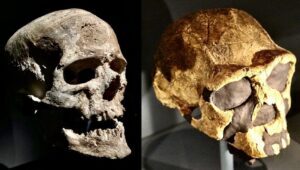
AMERICAN ASSOCIATION FOR THE ADVANCEMENT OF SCIENCE (AAAS)—Homo species – particularly Homo sapiens – were uniquely equipped to adapt to highly diverse environmental conditions and landscape mosaics, according to a new study*, which may have enabled our species and that of our closely related ancestors to survive and thrive in highly fluctuating Pleistocene environments. Homo sapiens are the only surviving hominin species today. However, whether this is because our species was uniquely successful at adapting to Pleistocene environments, because we outcompeted other contemporary Homo species through unique physiological or social adaptations, or because we simply outlived others by chance remains largely unknown. Although challenging to understand, the connection between hominins and their ecological environment, particularly how Homo species adapted to environmental change and extremes and how this affected survival and migration from Africa and into Eurasia, is central to finding these answers. Combining a transient 3-million-year Earth system-biome model simulation (BIOME4) with archaeological and fossil data for 6 different Homo species, Elke Zeller and colleagues investigated the preferred environmental conditions of the different hominin species, whether biome preferences changes in time or diversity across the Pleistocene, and how these choices affected hominin adaptation. Zeller et al.’s analysis shows that early African hominins, including H. habilis and H. ergaster, predominantly lived in open and dry grassland environments. H. erectus, upon leaving the African continent, settled in a much more broad suite of environments, including temperate forested regions. This trend continued for more recent species, like H. erectus and H. neanderthalensis, who were able to adapt to colder habitats. According to the findings, H. sapiens were able to occupy the most extreme environments, such as deserts and tundra, an ability that suggests the development of unparalleled cognitive abilities, allowing them to exploit habitat diversity and diverse food resources. Overall, the study reveals a pattern of Homo species preferentially selecting and adapting to areas with more diverse habitats over the last 3 million years.
______________________________

Homo sapiens (left) and Homo erectus (right) were the two most successful ‘globetrotters’ among the hominins. Left image: Zpanpana, Right image: Emőke Dénes. Creative Commons Attribution-Share Alike 4.0 International, Wikimedia Commons
______________________________
Article Source: AAAS article by Walter Beckwith
*Human adaptation to diverse biomes over the past 3 million years, Science, 12-May-2023. www.science.org/doi/10.1126/science.abq1288
Advertisement

Don’t miss out on this unforgettable evening as Dr. Hawass reveals the most closely guarded secrets of ancient Egypt and presents his groundbreaking new discoveries and latest research live on stage. As the man behind all major discoveries in Egypt over the last few decades and director of several ongoing archaeological projects, Dr. Hawass may yet surprise you with unexpected revelations that will make news across the world.




